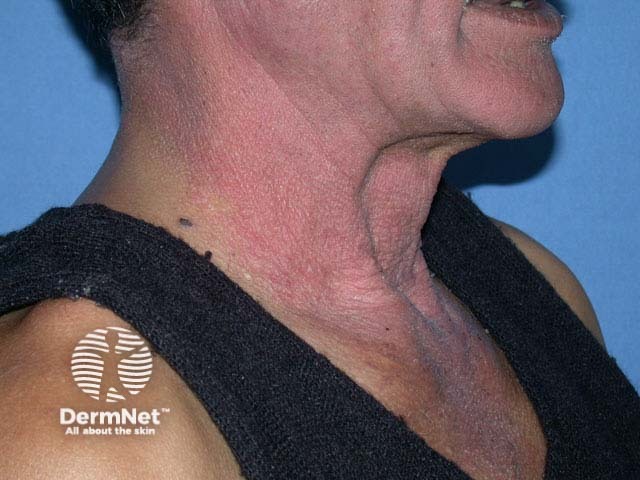Main menu
Common skin conditions

NEWS
Join DermNet PRO
Read more
Quick links
Cutaneous adverse reactions – 10 cases
Cutaneous adverse reactions to medications are common; many are non-immunological in nature. This quiz considers some drug eruptions believed to be immunologically-mediated ('drug allergy'), or that are at least idiosyncratic in nature.
Often it is difficult to be certain whether a rash is due to drug, a skin disease or an underlying illness. A careful drug history is essential, considering prescription and over-the-counter medicines, topical agents, herbal remedies and supplements. Previous exposure, dose, duration and frequency of drug administration should be established. Refer to standard textbooks and obtain specialist advice from a dermatologist as necessary.
For each of the ten cases, study the image(s) and then answer the questions. You can click on the image to view a larger version if required.
Each case should take approximately 2 minutes to complete. There is a list of suggested further reading material at the end of the quiz.
When you finish the quiz, you can download a certificate.
Case 5

Name this skin condition.
Photosensitivity dermatitis due to chlorpromazine
What are its clinical features?
Dermatitis is not often caused by the systemic administration of a drug. The main exception is drug-induced photosensitivity dermatitis i.e. photoallergic reactions due to delayed cell-mediated hypersensitivity (type 4). They should be distinguished from drug-induced phototoxic reactions, which present as an exaggerated sunburn reaction, but these are often caused by the same group of drugs that may cause photoallergy.
Photosensitivity dermatitis is of gradual onset and the patient may have been on the medication for a long time before it arises. The cause is often unrecognised by the patient, who complains of itchy dry plaques affecting the face, neck, hands and other exposed areas. Spared areas are found under a watch-strap, under the chin, behind the ears and in deep furrows. There is characteristically a sharp cut-off between exposed and unexposed areas, but this is not always present. Lesions on covered areas may arise because of inadvertent exposure, thin clothing through which long wavelength ultraviolet radiation penetrates or because of an autosensitisation reaction.
Unfortunately, photosensitivity dermatitis may persist long after the precipitating drug has been withdrawn, even months or years afterwards (persistent light reaction and chronic photosensitivity dermatitis). It can be very disabling. Initial treatment should be with emollients and potent topical steroids. The patient must be counselled regarding light protection; it is not just the sunburn spectrum that provokes the rash. Specialist advice should be sought if the rash fails to clear on stopping medications.
List drugs that are commonly responsible.
Drugs reported to cause photosensitivity dermatitis include ACE inhibitors, amiodarone, frusemide, thiazides, antipsychotics, tetracycline and statins.
